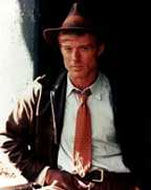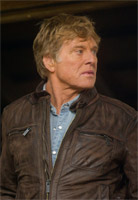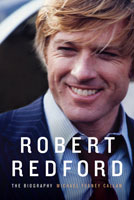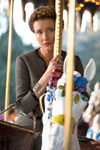Emma Thompson A Walk in the Woods
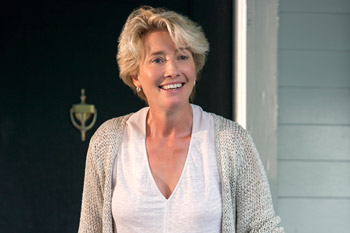
Emma Thompson A Walk in the Woods
Cast: Emma Thompson, Kristen Schaal, Nick Offerman, Robert Redford
Director: Ken Kwapis
Running Time: 103 minutes
Synopsis: After spending two decades in England, Bill Bryson returns to the U.S., where he decides the best way to connect with his homeland is to hike the Appalachian Trail with one of his oldest friends.
A Walk in the Wood
Release Date: September 3rd, 2015
About the Production
Three Men, One Book and More Than 2,000 Miles of Mother Nature: The Making of A Walk In The Woods
Robert Redford's first reading of Bill Bryson's A Walk in the Woods was more a fluke than anything else. The legendary actor, filmmaker, naturalist and political figure had a copy of the book among a pile of others on his desk, and literally running out the door to begin a 2002 vacation with his wife, Robert Redford made a split-second decision to bring it along.
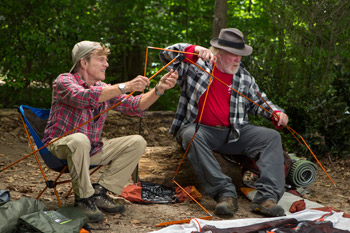 He recalls, 'There was this book sitting on my desk that had sat there for some while. It had a picture of a bear in a forest, so my first thought was that this was another one of those environmental books I get sent. So I was on my way out and I thought, -Oh, I'll take this along.' So I read it, and it was the first time I could remember laughing out loud so many times while reading a book. That spurred me to try to get the rights, because I could see it as a film that would be for Paul Newman and me – that's how it started."
He recalls, 'There was this book sitting on my desk that had sat there for some while. It had a picture of a bear in a forest, so my first thought was that this was another one of those environmental books I get sent. So I was on my way out and I thought, -Oh, I'll take this along.' So I read it, and it was the first time I could remember laughing out loud so many times while reading a book. That spurred me to try to get the rights, because I could see it as a film that would be for Paul Newman and me – that's how it started."
American author Bill Bryson – whom the UK's Telegraph dubs 'Britain's best loved transatlantic import" – shot to literary stardom in his adopted country with the publication of Notes from a Small Island in 1996. An accompanying series by Carlton Television aired in 1998, and the book was chosen by Britain's Radio as the best ever written about the British Isles. Shortly after the publication of Notes, he and his family relocated back to the states, and his book detailing his attempt to 'rediscover America on the Appalachian Trail," A Walk in the Woods, became a New York Times bestseller when published in 1998 (with the paperback in 1999).
As the project journeyed through the inevitable years of the development process, 'where things went up and down, people fell out, people fell in, people fell out again. Paul Newman's health declined; his age became an issue very early on. Pretty soon that was out. Later, I thought of Nick Nolte, because I thought he would be really ideal. I was so passionate about it – it's one of those things where you just don't give up. Perseverance has rewards sometimes; you keep going because you believe in it. So, that's why we're here."
'Here" is Georgia, near the southernmost point in the famed Appalachian Trail, one of the longest continuous footpaths in the world, measuring roughly 2,180 miles. Those who attempt to cover the Trail in one continuing trek are known as 'thru-hikers," whereas 'section-hikers" walk separate portions of the Trail over years and 'flip-floppers" thru-hike the Trail disjointedly, hitting different portions at different times in attempts to start off on one of the lesser challenging treks, or to avoid harsh weather and/or crowded trails. In A Walk In The Woods, Bill Bryson thinks to shake up his life and challenge hims
elf with a thru-hike, timed like most, beginning in Georgia in the spring. But, as with even the best laid of plans, things do not go as he envisioned, and paths veer into unintentional and humorous terrain.
Director Ken Kwapis – known for his work directing such favorites as He's Just Not That Into You and The Sisterhood of the Traveling Pants – explains, 'When I first read A Walk In The Woods, I was struck by the fact that this -two-hander' really has three main characters: Bill Bryson, his old friend Katz and the Appalachian Trail itself. I had just directed the rescue-adventure Big Miracle, which pitted characters against an extreme environment – northern Alaska in the dead of winter – and I relished the chance to tell another story in which the natural world plays an important role. Also, like Bill Bryson, I felt a strong urge to go into the woods, literally and figuratively. I yearned to unplug the computer, put away the cell phone and have an unmediated experience of nature."
Big environmental themes and admirable aims aside, there was another strong draw for Ken Kwapis: 'I was struck by how funny it is. You don't usually reach for travel writing if you're in the mood for a laugh, but A Walk in the Woods is knee-slappingly funny – I'm not ashamed to admit that I actually slap my knee now and then when prompted by something mirthful. Yes, A Walk In The Woods is a journey of self-discovery, and its themes are quite profound, but it often plays out like a Hope and Crosby road movie."
You Can't Walk Alone: Casting Nick Nolte and the Supporting Roles
Picturesque road, check. Passionate director, check. Holderman's facile screenplay, one performer/producer, check, check – and time did come for the one -hand' to find another. For all of their prolific efforts, iconic homegrown talents Robert Redford and Nick Nolte had their first collaboration on 2012's The Company You Keep. It was after directing Nolte in the feature that Robert Redford felt compelled to 'resurrect" A Walk In The Woods, according to Ken Kwapis. Shortly after, Robert Redford placed a call. Nick Nolte tells, 'I got a call from Robert Redford maybe twoand- a-half years ago, and he asked me if I'd come in and have a chat with him. I went in and talked to him, and we discussed the Bill Bryson book, A Walk in the Woods. He filled me in on the history that he and Paul Newman were going to do it at one time. After the meeting, he said, -Look, I'll get you a script and you can read it.'"
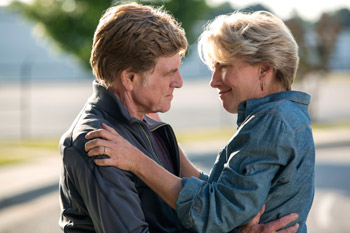 Nick Nolte's reaction was immediate and personal. 'I said, -This is a great script.' For actors our ages, it is a perfect piece of material. It looks at the challenge of aging – which is difficult enough in life, let alone in trying to go on some kind of adventures. But adventures are important in every stage in your life. I think we psychologically go through changes, maybe every 10 years. We're 10, then we're 20, 30, then we are in our middle age, 40s. We go on to old age around 70, to start what Katharine Hepburn called -the boring part of life,' watching your body fall apart. But during all aspects of life, it's the continuing forward, that is where you want to go. These two guys are pretty much about that – they're fed up with what they have been doing most of their lives. Even Bill Bryson, with his success and everything, is still wondering about his choices."
Nick Nolte's reaction was immediate and personal. 'I said, -This is a great script.' For actors our ages, it is a perfect piece of material. It looks at the challenge of aging – which is difficult enough in life, let alone in trying to go on some kind of adventures. But adventures are important in every stage in your life. I think we psychologically go through changes, maybe every 10 years. We're 10, then we're 20, 30, then we are in our middle age, 40s. We go on to old age around 70, to start what Katharine Hepburn called -the boring part of life,' watching your body fall apart. But during all aspects of life, it's the continuing forward, that is where you want to go. These two guys are pretty much about that – they're fed up with what they have been doing most of their lives. Even Bill Bryson, with his success and everything, is still wondering about his choices."
The choice of Nick Nolte as Katz was nearly a foregone one. Robert Redford comments, 'Nick Nolte is a really accomplished actor, and also a sharp guy. What sits underneath, though, are the qualities that I thought were right for this film. He sometimes can play the clown, and he can play the disheveled part of himself, but he's actually smart and a good actor. I've appreciated that and I'm happy to be working with him. He fits the character well, and not just the one side of the clown/buffoon."
Ken Kwapis feels that it's exactly 'what sits underneath" that brings the heft – and the comedy – to the piece. He says, 'Something that struck me about A Walk In The Woods is that it's a character piece disguised as a travel memoir. It's about what constitutes real friendship. It's also about lost time. I have certainly fallen out of touch with good friends from my past. I make lists of people I intend to reconnect with, but I never seem to get around to doing it. Time doesn't give you a break, and I would regret not finding – no, making that time to circle back and honour friendships that were once passionate but are now mere echoes. Katz bursts into Bill Bryson's life at a key moment. Bryson feels that his creative life has reached a dead end. Everywhere he looks he sees portents of his own mortality. Katz's return is timely and more than a bit karmic."
Common sense tells you that if you're going on a road trip, you better surround yourself with people you like. Robert Redford is his pragmatic, straightforward self when talking about Ken Kwapis: 'I like Ken Kwapis; he's smart, kind, easy, but underneath that is a strong conviction. He has a wonderful sense of comedy. As an actor, I've appreciated working with him, because he will give opportunities for nuance. You can try different ways of doing something, which appeals to me, particularly if you are an actor that's been brought up through craft rather than just personality – and mine was in the theatre and early live television. So, understanding that, and if you're an actor and you have pride in being an actor, then there are different ways you can deliver a performance. Many directors these days are more focused on the technological part of it – they'll do take after take, but they are more interested in what the camera's doing. They're not thinking so much about the different ways a character can portray a scene and it still be truthful. Ken Kwapis understands that, so that's a joy for me."
Ken Kwapis notes that the link between the two main characters has grown threadbare over the decades they've been apart. He says, 'The last time Katz and Bill Bryson saw each other, they had a huge falling out. Katz, now a recovering alcoholic and all-around burnout, still owes Bill Bryson money...from the last century. By contrast, Bill Bryson seems to have it all: a successful literary career, a loving wife, a stable family. And yet, something is missing for him.
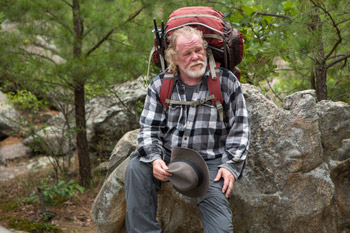 Something fundamental. What is it? Well, in order to find out, Bill Bryson must reconnect with his past, in the form of his old friend Katz. I don't know why Katz bursts into his life at this moment, but he represents that link to an earlier Bill Bryson – a passionate, less inhibited Bill Bryson."
Something fundamental. What is it? Well, in order to find out, Bill Bryson must reconnect with his past, in the form of his old friend Katz. I don't know why Katz bursts into his life at this moment, but he represents that link to an earlier Bill Bryson – a passionate, less inhibited Bill Bryson."
For working under challenging circumstances – there's a reason only one in four who attempt to thru-hike the Trail is successful – and with such a relatively intimate cast and crew, talk of the desired group dynamic was more than just lip service. Nick Nolte explains, 'Working with Bob, there is just such an honesty, a trust. It's hard for an actor to find this ensemble feel of trust…with Bob, that's the basis of it. If the trust is there, you can do something. I knew immediately on the first meeting that this was an actor – he's been through the games, through trying to be the lead of a film – who doesn't have to be the -star.' He's willing to put the material over your own personal story or success as an actor. And, in this case, to let nature be the star."
For Robert Redford, such an attitude is, in reality, a strongly held personal conviction. 'It's very important that when you work with the crew, you honour the crew you're working with…it's not just one person or two. When you're working, you treat the crew as one. I know there's a lot of talk about the auteur, and I'm not for that. It's a collaborative medium, so honour it. The soundman, the cinematographer, even the person preparing catering, they all contribute to the experience, and you either treat it like a family or you don't. I like the idea of a family, and you honour every single role in it. If you're a conductor with an orchestra, you don't just favour the violin section, or the horn section. You honour every single instrument, because it contributes to the whole. That's how I feel about film."
With a presence such as Robert Redford on the project, some might surmise that he himself might helm the film. Regarding his double duty as actor and producer, Robert Redford professes, 'I'm producing it because I got the rights, but there are other producers involved, Bill and Chip." Nick Nolte relates something he observed at the beginning of principal photography. As is customary, Robert Redford's name and his character name were affixed to the door of his trailer, and after the name was the word 'Producer." Robert Redford pulled the sign off the door, stating he didn't want to have to weigh in on overall decision-making during the filming process, what he really wanted to focus on was the acting. He (and the others) happily handed those duties off to producers Holderman and Diggins.
Ken Kwapis stresses that, 'Bob really wanted to take off his producing hat and focus on creating the character of Bill Bryson, a character that gave Bob a chance to exercise his comedic muscles, something he hasn't done in a while. Bob's approach to the craft could not be more thoughtful. There's nothing flashy about Bob's acting: he builds the character in incremental steps, detail by detail. He always invites you into the character's thought process. Soon, you forget you're watching Robert Redford because you're completely absorbed by Bill Bryson."
Out of all of his colleagues and friends, Bill Bryson only receives one positive response to his call-to-arms to hike the Trail…from Katz, whom Bryson didn't call (Katz heard about it through a bud), and who now clambers down the stairs from a small plane, having left Iowa behind. He's compelled more by a desire to escape some sticky situations back home than by any longing to reconnect with nature or challenge himself to beat the odds by conquering the Trail.
Bill Bryson's many years spent living in the UK did more than gain him notoriety, it also brought him a British wife, winningly portrayed by Emma Thompson. Her scenes with Redford stand as their first appearance together on-screen. Emma Thompson comments, 'This is far from the first time I have played a character that injects a note of British practicality into a situation. And I can't think of any other artist more -American,' in the most positive way, than Robert Redford. So I found it the greatest of pleasures playing our scenes together. I think if any woman's husband of a certain age expressed such a wish as, -I think I'll get out of bed today and begin a 2,000 mile hike,' she would do everything she could to dissuade him, no matter what her nationality. I think we Brits possess an arsenal of persuasive techniques. Failing those, we can always just come out and shout, -Have you gone mad?!', which I believe I also do at some point."
Ken Kwapis explains his feelings on directing Emma Thompson: 'She's incredibly versatile and she's game for anything. As a director I threw her all sorts of curve balls, and she simply knocked each one out of the park. It was an embarrassment of riches: each take was wildly different and equally strong. Comedically, Emma Thompson's not afraid to go out on a limb, but no matter how bold the choice, she always manages to keep things grounded. Emma Thompson's character bookends the film, and one could say the entire story is really about Bryson making his way back to his wife Catherine. She is the Penelope to Bryson's Ulysses. The film doesn't work unless their reunion is heartfelt. Happily, Bob and Emma Thompson have terrific chemistry. There's never any doubt that Bryson is completely in love with Catherine; as a result, she's present throughout the story, even when she's not onscreen."
Also worth noting is the presence of phenomenal talent in supporting roles – including Mary Steenburgen, Kristen Schaal and Nick Offerman – along with sterling behind-the-camera artisans such as screenwriter/producer Bill Holderman, producer Chip Diggins, production designer Gae S. Buckley, editors Carol Littleton and Julie Garcés, costume designer Leigh Leverett, composer Nathan Larson and the band Lord Huron.
As they both set out to do what many men half their age can't, reminiscences float to the surface, along with aches, pains, previously unvoiced jealousies and more than a handful of profound silences in the presence of some of the most beautiful landscapes the country has to offer, all captured on 35mm film (chosen for its portability and for the texture 'you can only get on film") and digitally by gifted cinematographer John Bailey – A Walk In The Woods is Bailey's sixth collaboration with Ken Kwapis. The project served as a significant reunion for the cinematographer and Robert Redford – Bailey had shot a short film with Robert Redford ('I don't even know if John remembers or not," he says) and a decade later, the cinematographer went on to film Robert Redford's feature film directing debut, Ordinary People, which garnered six Academy Award nominations and won four Oscars, including for Best Picture and Best Director.
It's Always a Good Time: Fun on Set
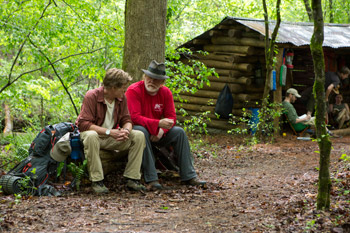 Both Nolte and Robert Redford also brought a sense of exploration to their character work, in particular, how they chose to navigate scenes and arrive at the objectives offered by Ken Kwapis. In short, they sometimes gave the director s&*t.
Both Nolte and Robert Redford also brought a sense of exploration to their character work, in particular, how they chose to navigate scenes and arrive at the objectives offered by Ken Kwapis. In short, they sometimes gave the director s&*t.
Nolte tells, 'I always mess with the director, because I get some kind of feel from him out of what to play…so I sometimes take counterpoint, and say, -Oh, this is silly.' Then I either get the director's fury, or his humour and irony, or I get ignored. Bob picked up on it, so we both kind of butted Ken around. And he enjoyed it, but that's the kind of humour we're into – we're into irony. Aging is irony. It's not Animal House humor. We don't have the luxury of thinking we will die, someday. We know we're going to die, so everything is ironic to us."
'Every day," Nolte continues, 'we would come in and say, -Well, this is going to be a snap.' And then the next day, Bob and I would say, -God, was that hard.' There wasn't a break. There's nothing you can walk through; everything is hard. But because of that, it's very engaging, just being here, filming. It's been a ball."
None of this is lost on Ken Kwapis. He affirms, 'When I met Robert Redford for the first time, I told him that what I loved about this project was its optimism. When I direct, I try to come up with a mantra that encapsulates what I hope to express, something I can rely on when I become overwhelmed by the task at hand. For A Walk In The Woods, the phrase I chose is simply this: life requires living. Bryson and Katz's 2,200-mile journey could not be more illadvised.
Neither man is in prime shape. Bryson, who instigates the trek, is even hardpressed to explain why he's doing it at all. But what's clear to me is that Bryson and Katz have embarked on this cockeyed adventure because they simply will -not go gentle into that good night.' They're thumbing their nose at the naysayers; indeed, they're thumbing their nose at death itself. Until it's over, they remind us, the game is still afoot."
Inevitably, talk turns to cinematic intentions – for a majority of those involved, the story they were choosing to tell is quite clear. For Nolte, it's 'have fun before you die." But when the notion of moviegoers is thrown into the mix, Redford is more hesitant to speak in any way approaching clairvoyance. He closes, 'What I would hope an audience would take away would be exactly what I hoped the film would be – which is a combination of humour and pathos, with the comedy coming from something that's real, that has to do with humanity."
And for someone as sublimely accomplished as Redford, that doesn't seem like a lofty aspiration at all.
Sounds of Nature: The Music of A Walk In The Woods
The choice of the musical landscape of A Walk In The Woods was as well thought out as the actual vistas in film. Bill Holderman had pushed the band Lord Huron onto the filmmakers' radar by sharing their first album, Lonesome Dreams, with Ken Kwapis, Diggins, Robert Redford and the others.
Ken Kwapis relates, 'There's a review I read of Lonesome Dreams that describes the songs as making you feel like you're in a national park. Needless to say, that sound could not be more appropriate for A Walk In The Woods. What I love about Lord Huron's music is its rich textures. Lord Huron creates a wall of sound – a wall of natural sound. You really feel like you're in a dense forest; it's as if the natural world is singing to you. The effect is both epic and intimate, and it's perfectly suited to Bryson and Katz's journey, which has both physical scope and quiet introspection. Lord Huron composed a song especially for A Walk In The Woods; appropriately, it's entitled -Birds Are Singing.'"
Many other recording artists make contributions to A Walk In The Woods. Kwapis describes their sound as 'alt-Americana. Artists like Blake Mills, Chatham County Line, Shovels and Rope, and Great Lake Swimmers bring Bryson and Katz into a contemporary musical world...but one that is intelligent enough to know where the important roots lie." Kwapis adds, 'Providing the glue for this eclectic mix is Nathan Larson's guitar-driven score, which gives the journey its pulse...and its heart."
What Happens Over 2,200 Miles? About the Appalachian Trail
A Walk in the Wood
Release Date: September 3rd, 2015
Have You Seen This?
MORE
- Mission: Impossible Fallout
- Glenn Close The Wife
- Allison Chhorn Stanley's Mouth Interview
- Benicio Del Toro Sicario: Day of the Soldado
- Dame Judi Dench Tea With The Dames
- Sandra Bullock Ocean's 8
- Chris Pratt Jurassic World: Fallen Kingdom
- Claudia Sangiorgi Dalimore and Michelle Grace...
- Rachel McAdams Disobedience Interview
- Sebastián Lelio and Alessandro Nivola...
- Perri Cummings Trench Interview

